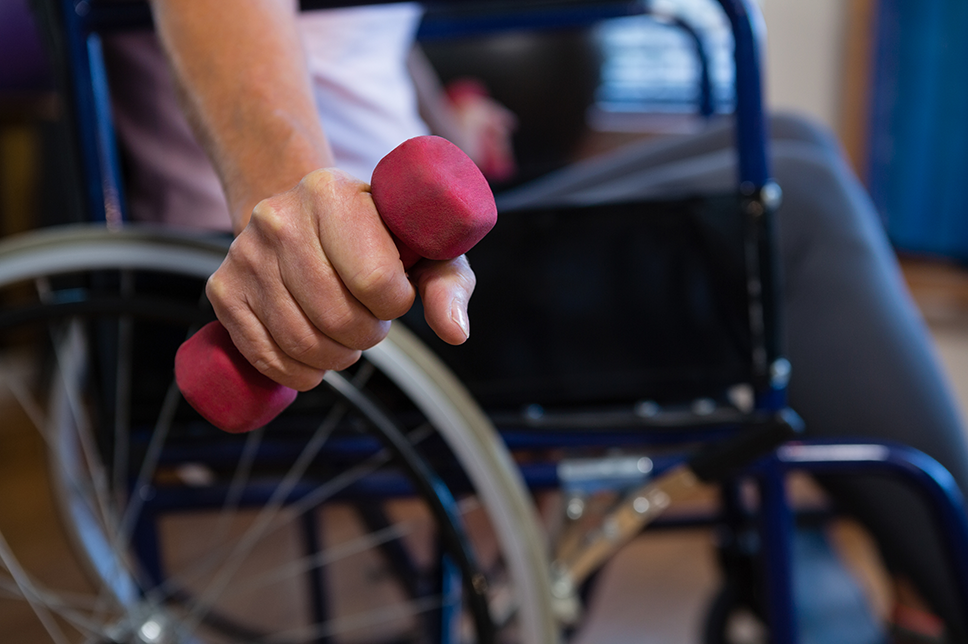
Exercising and maintaining a fitness routine has been proven beneficial in ways extending beyond improving one’s physical health. Basic physical fitness can hinder chronic disease development and ease your ability to complete daily physical tasks. But did you know regular exercise enhances self-esteem and encourages your sense well being? To a person with a disability, exercise may seem difficult or even impossible at times. However, creative approaches to at-home workouts utilizing adaptive gym equipment has made it possible for those with limited mobility to experience the many benefits of feeling fit. From seated cardiovascular exercises to adapted weight and flexibility training, there’s a plethora of options for those with disabilities to incorporate into their daily lives. So get physical with adaptive exercise and equipment today !
As with any fitness routine, safety is top priority. Before beginning any exercise program, be sure to consult your physician and discuss your goals and abilities regarding your training. Drink plenty of fluids, warm up and cool down before and after your workouts, and listen to your body to prevent injuries. If your workouts require you to leave home, ensure you are using safe modes of transportation.
Cardiovascular Exercises
Cardiovascular exercises raise the heart rate and increase blood flow while building stamina. Despite popular belief, cardio doesn’t have to include a treadmill or running of any kind. Any fast paced, repetitive exercise will offer heart-healthy benefits and include many options for those with restricted mobility.
Chair aerobics is an easy, effective and accessible way to practice cardiovascular training. Simple air punches are an example of a seated workout that offers cardio benefits and can even include weights for added resistance. Water aerobics is another viable option for individuals with limited mobility, however pool therapy programs that are wheelchair accessible may be difficult to find. Adapted equipment, such as a pedal exerciser, is modified for hand use only and can be used anywhere you’re most comfortable.
Strength Training
Strength and weight training exercises increase muscle strength and bone mass while improving balance and building endurance. This type of exercise can often be completed from a seated position by engaging in movements such as shoulder presses and bicep/tricep curls with minimal equipment. Resistance bands, wrist and ankle weights and gripping aids are types of mobility equipment specifically designed for those with disabilities to promote strength and weight training.
Flexibility
Incorporating stretching and flexibility exercises into your daily routine can lessen pain and pressure in muscles often associated with living with limited mobility. Even gentle stretching of areas like the neck, arms and wrists can improve elasticity and relieve stress on the joints. Most flexibility workouts can be modified for those with disabilities, with exercises such as chair yoga being offered at certain gyms and health clubs. Stretching should also be incorporated into workout routines in order to prevent soreness and injury.
These are just a few of the more common ways people with disabilities get active in their daily lives. Of course, you can always get creative with your workout regimen and work your interests into your routine. Who said you have to miss your favorite TV shows while you workout? Whether you’re looking to build muscle mass, are in need of stress relief, or just want to shake up your daily routine, if there’s a will then you’re on your way to becoming more heart-healthy and physically fit than ever. So get going with adaptive exercise and equipment !
The National Mobility Equipment Dealers Association (NMEDA) is an advocate for mobility and accessibility for drivers with disabilities. If you need help with converting or buying a handicap accessible car, truck or van, please consider one of our mobility equipment dealers. Find a dealer near you: www.nmeda.com/locatedealer
** This post was originally published on https://nmeda.com/get-physical-with-adaptive-exercise-and-equipment/

